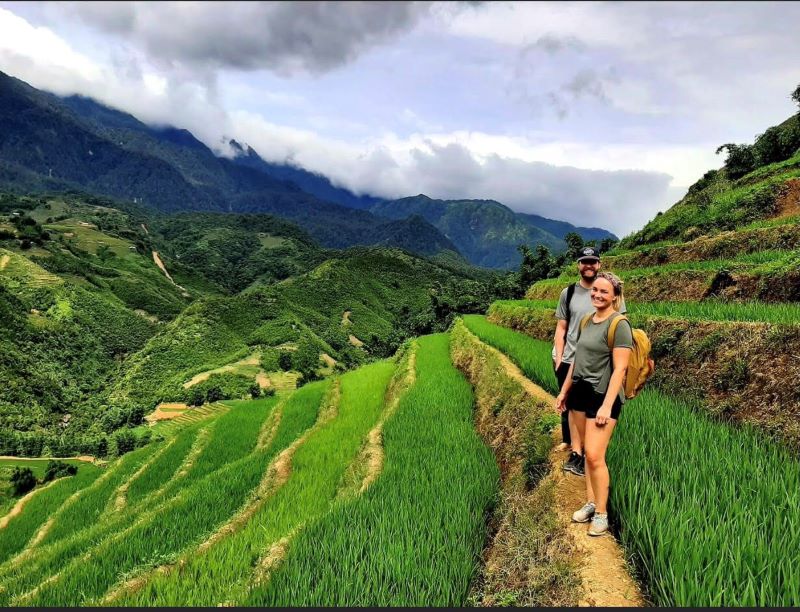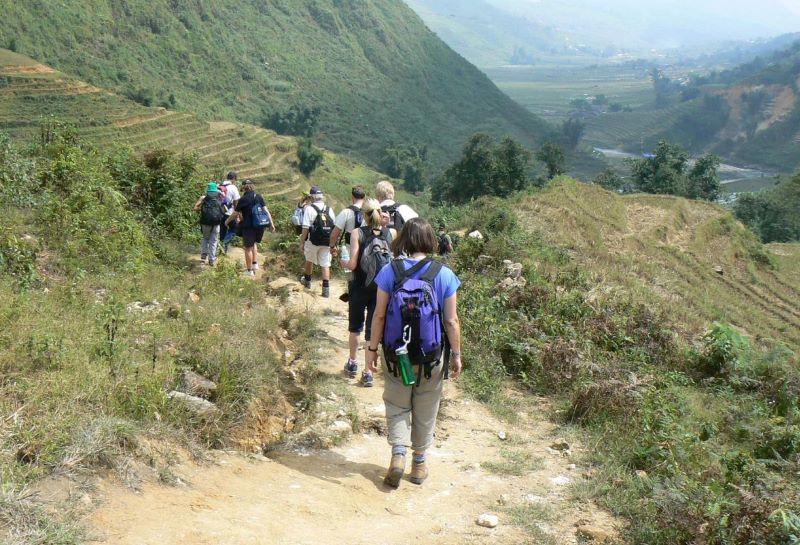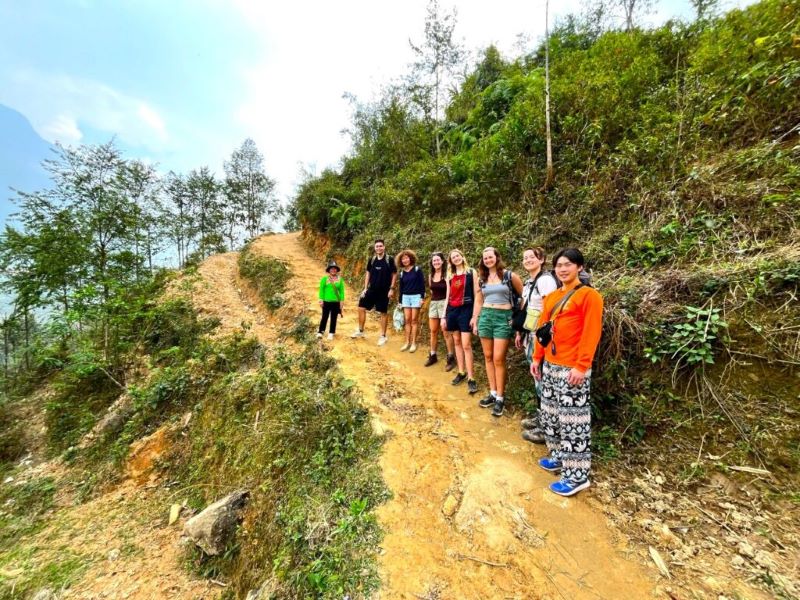Sapa is a beautiful land located in the Northwest of Vietnam, an ideal destination for those who love trekking and exploring nature. With diverse routes, from easy for beginners to challenging for professional trekkers. Sapa offers a great opportunity to immerse yourself in the majestic landscape and diverse cultures of ethnic minorities.
Reasons to choose trekking in Sapa
Trekking in Sapa is not just a walking journey but also an opportunity for you to explore the beautiful natural landscapes and gain a deeper understanding of the lives of ethnic minorities. With majestic mountains, vast valleys and terraced rice fields, every step brings impressive views that cannot be found anywhere else.

Besides, Sapa is famous for the unique culture of ethnic groups such as H’Mong, Dao Do, Tay, Giay. When trekking through the villages, you will have the opportunity to participate in the daily lives of the people, enjoy traditional cuisine, and learn about interesting customs and practices. These experiences make your trekking journey not only emotional but also extremely meaningful.

In addition, trekking in Sapa also helps you exercise, improve endurance and patience. This is the perfect activity to escape the hustle and bustle of daily life, immerse yourself in fresh nature and relax your mind. These are the reasons that make trekking in Sapa an unmissable experience for those who love adventure.
What is the best time to go trekking?
Sapa has its own beauty in each season, but to make your trekking journey the most convenient and memorable, you should choose the right time. Spring (March to May) and autumn (September to November) are two periods considered the most ideal for trekking in Sapa.

In spring, the weather is cool, hundreds of flowers bloom, creating a vibrant scene. This is also the time when villages are bustling with daily activities, helping you easily immerse yourself in the lives of the indigenous people. Meanwhile, autumn brings a romantic scene with golden ripe terraced fields, stretching across the valleys. The weather this season is dry, convenient for traveling on trekking routes.
In addition, if you love snow-covered roads and are not afraid of the bitter cold, winter (December to February) is also an interesting choice. However, you need to prepare carefully in terms of clothing and physical strength to ensure safety. Summer (June to August) often has rain, slippery roads, but the mountain scenery is greener and more vibrant than ever, suitable for experienced trekkers.
The best trekking routes in Sapa
Easy trekking trails for beginners
Cat Cat Village – Journey to Discover Ethnic Culture
Cat Cat Village, located only about 2 km from the center of Sapa town, is one of the most popular trekking destinations, especially ideal for those who are just starting their journey to explore the Northwest highlands. Known for its poetic natural beauty and the rich culture of the H’Mong people, Cat Cat offers memorable experiences for both families and young travelers.

The trekking journey to Cat Cat is quite easy and gentle, with the path mainly consisting of stone steps and carefully paved slopes. Although not requiring much physical strength, each step here brings new perspectives on nature. Along the road leading to the village, you will admire the majestic beauty of the Northwest mountains and forests, the terraced fields stretching on both sides of the road, and the fresh air typical of the highlands. This is a suitable route for both walking and sightseeing, especially for families with young children who want to explore and enjoy the scenery together.

When entering Cat Cat village, the first thing you will feel is the traditional cultural space of the H’Mong people. The wooden stilt houses, with quiet and ancient architecture, are interspersed along the mountainside, creating an extremely poetic village picture. This is not only a place for people to live but also a vibrant space for traditional crafts passed down from generation to generation.
You will have the opportunity to witness the meticulous brocade weaving process, from spinning, dyeing with forest leaves to weaving fabrics with sophisticated patterns. In addition, silver carving is also a prominent feature, with elaborate handcrafted products, demonstrating the ingenuity and sophistication of the indigenous people.
Not only stopping at handicrafts, Cat Cat village is also famous for traditional art performances. The Khen dance, Xoe dance and folk songs are performed by the locals right in the village, giving visitors a vivid look into the culture and soul of the Hmong people. You can immerse yourself in the vibrant atmosphere of these performances, even join in dancing with the locals to feel more clearly their joy and hospitality.
Ta Van Village – Immerse Yourself in the Life of Ethnic People
About 10 km from the center of Sapa town, Ta Van village is one of the must-see destinations for those who want to learn more about the life and culture of ethnic minorities. This is the main habitat of the Giay and Red Dao people – two ethnic groups with a long history and unique cultural characteristics, creating an irresistible attraction for domestic and foreign tourists.

The trekking journey to Ta Van is quite easy, suitable for even beginners. The route is mainly trails through lush green terraced fields, bringing a sense of closeness and peace. In particular, during the rice harvest season (September – October), the landscape here becomes brilliant with shimmering yellow colors stretching across the hillsides, creating a fascinating natural picture. On the way, you can also encounter small streams flowing through the crevices of the rocks, creating a gentle and relaxing sound.
When you set foot in Ta Van, you will feel the hospitality and friendliness of the local people. This is an ideal place to experience homestay – a form of accommodation that allows visitors to live with ethnic families, thereby understanding more about their daily life. In the simple but cozy space of traditional houses, you will have the opportunity to participate in daily activities such as cooking, farming, or raising livestock. Being able to plant rice on terraced fields or learn how to prepare specialties from local people will definitely bring you memorable experiences.

The evening in Ta Van is a particularly warm and intimate time. After a long day of exploring, you can sit around the fire with a local family, enjoy fragrant corn wine, sip local dishes and listen to stories about the village, about life in the highlands. The cheerful laughter mixed with the crackling sound of burning firewood will make you feel more attached to this land.
Trekking routes with medium difficulty
Lao Chai Village – Ta Van – Explore Muong Hoa Valley
The journey from Lao Chai village to Ta Van village, about 12 km long, is one of the most famous trekking routes in Sapa, taking visitors through Muong Hoa valley – known as one of the most beautiful valleys in the Northwest. This is not only a journey to admire the majestic natural scenery but also an opportunity for you to immerse yourself in the simple life of ethnic minority villages.

The road from Lao Chai to Ta Van is not too difficult, but it also requires patience and endurance, especially on steep and narrow roads. Trekking through small winding trails between mountains and forests, you will feel the tranquility and freshness of nature, something that urban space can hardly bring. The terraced fields stretching across the hillsides are the main highlight of this route, especially in the ripe rice season (September – October), when the brilliant yellow color of rice covers the entire valley, creating a magnificent natural picture.

Along the way, you will pass by small clear streams flowing between the rocks, where you can sometimes stop to rest and enjoy the cool water. Interspersed among the mountain scenery are small villages of the H’Mong and Giay ethnic groups, where you can stop, chat with the locals and learn about their unique culture. The H’Mong in Lao Chai are famous for their traditional brocade weaving, while the Giay in Ta Van give visitors a deeper insight into their farming life and typical cuisine.
Not only beautiful in the ripe rice season, Muong Hoa valley also has its own beauty in each season of the year. In spring, the landscape here is adorned with peach and plum blossoms blooming all over the hillsides, while summer brings a sense of clarity with the lush green of young rice. Especially when trekking through these roads in winter, you will experience the cold air typical of the highlands, with mist covering the entire valley, creating a scene that is both magical and poetic.
Sin Chai Village – Experience the Life of the Red Dao People
Sin Chai village, located about 4 km northwest of Sapa town center, is one of the attractive trekking destinations for those who want to explore the wild beauty and unique cultural life of the Red Dao people. Not too far but enough to escape the hustle and bustle of the city, the journey to Sin Chai village brings a peaceful, slow and close-to-nature feeling.

The trekking journey to Sin Chai is moderately difficult, suitable for trekkers with a little experience. The route here is not flat like other easy trekking routes, but includes steep, gravel-covered roads, winding through the mountainsides. Along the way, you will pass through dense forests, with green trees, providing shade and fresh air. The closer you get to the village, the quieter the scene becomes, with only the chirping of birds and the babbling of streams flowing through the rocks, creating a natural picture that is both wild and poetic.
When you arrive at Sin Chai village, you will be welcomed by the idyllic scenery of traditional wooden houses scattered on the hillsides. This is the home of the Red Dao people, one of the ethnic minorities with unique cultures in Sapa. One of the highlights in Sin Chai is the sophisticated embroidery of the Dao people. The brocade fabrics are hand-embroidered with elaborate patterns, symbolizing nature and the beliefs of the people, demonstrating their ingenuity and talent. You can not only admire but also participate in the brocade making process under the guidance of local artisans.

In addition, Sin Chai village is also famous for the specialties of the Red Dao people, such as hill chicken, grilled stream fish, and fresh wild vegetables. These dishes are made from completely natural ingredients, grown or caught by the local people. This is not only an opportunity for you to enjoy unique cuisine but also to learn more about the simple lifestyle, closely connected to nature of the people here.
Challenging trekking routes
Fansipan Peak – Conquering the Roof of Indochina
Fansipan Peak, with an altitude of 3,143 meters, is known as the “Roof of Indochina” and is the dream destination of many trekkers when coming to Sapa. With the majesty of the Northwest mountains and forests and the feeling of pride when conquering this peak, the Fansipan journey is not only a physical challenge but also an iconic experience in life.

To conquer Fansipan, you need good health, perseverance and basic mountain climbing skills. This journey is not only a test of physical strength but also requires careful preparation, from choosing the right route, preparing cold-proof clothes to bringing enough food and water. There are many routes to climb Fansipan peak, but the most popular is the Tram Ton route, chosen by many trekkers because it is both safe and allows you to experience a variety of terrain. This journey usually lasts from 2 to 3 days, depending on the speed and health of each person.
On the way up the mountain, you will pass through many different types of terrain, from cool bamboo forests, dwarf bamboo forests covered in mist to challenging cliffs. Each section of the road is a separate challenge but also brings unique perspectives of majestic nature. You will have the opportunity to admire small roads along the mountainside, typical highland vegetation, and especially flocks of birds flying in the air, creating a vivid natural picture.

When reaching an altitude of nearly 3,000 meters, the air begins to become thinner, the temperature drops significantly, and the scenery opens up with layers of white clouds floating. The feeling of getting closer to the highest peak makes all fatigue disappear. Especially, the moment standing on the top of Fansipan, you will feel the vastness of the Northwest mountains and forests. From here, your eyes can reach majestic mountain ranges, deep valleys covered by white clouds, and the peace of remote villages.
Su Pan Village – Ho Village – Discovering the Wild Beauty
The route from Su Pan village to Ho village, about 15 km long, is an attractive trekking journey for those who want to challenge themselves and explore the wild beauty of Sapa. This is one of the lesser-known routes but offers a unique and profound experience, helping you immerse yourself in nature and learn about the lives of ethnic minorities here.

The road from Su Pan to Ho village is not easy, especially with steep slopes and narrow trails through the old forest. However, that difficulty is the highlight of the journey, because it opens up before your eyes beautiful natural landscapes that few places have. You will pass through primeval forests, where the trees are dense and the air is so fresh that every breath becomes lighter. Interspersed among them are small streams flowing, creating a gentle natural melody. On the way, you can also encounter majestic waterfalls pouring down from the high mountainsides, bringing a feeling of both awe and relaxation.
When arriving at Ban Ho, you will immediately feel the peace and simplicity of a village deep in the valley. Ban Ho is home to the Tay people – an ethnic minority with many unique cultural features. One of the great experiences here is soaking in natural hot springs. The warm water not only helps you relax after the trekking journey but also brings you a feeling of being closer to nature than ever.

In addition, Ban Ho is also an ideal destination to enjoy traditional dishes of the Tay people. Dishes such as grilled stream fish, hill chicken, and purple sticky rice are not only delicious but also made from completely natural ingredients, grown and caught by the local people. This is also an opportunity for you to sit down, chat and learn about the culture and customs of the Tay people, from folk tales to unique rituals associated with their daily lives.
Sapa trekking offers an incredible range of experiences for everyone – from culture lovers and history buffs to nature lovers and adventure seekers. Sapa trekking trails are a testament to the harmonious coexistence of nature and man. Whether you are craving a challenge, a leisurely stroll or the chance to immerse yourself in local culture, Sapa trekking routes offer unique experiences that will enrich your soul and leave you inspired by the beauty of northern Vietnam.



